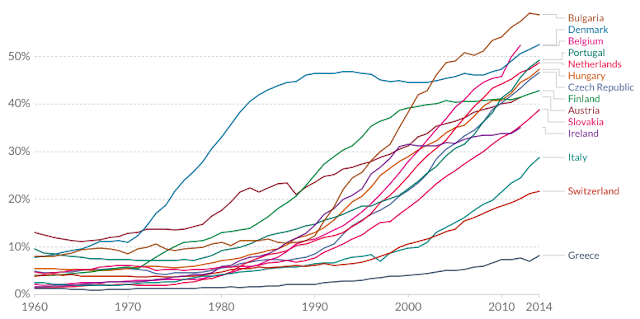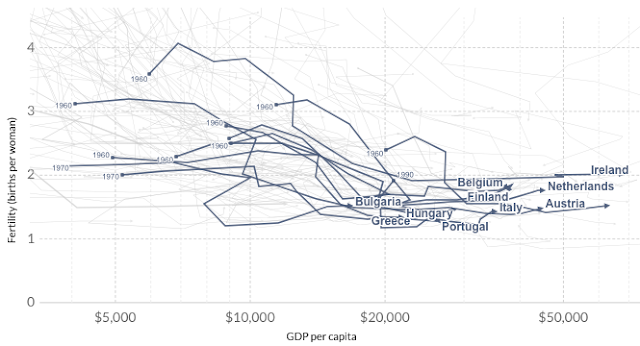Births, marriages and divorces in Europe: Evidence for a sample of 14 countries over 1960-2017
by Tryfonas Lemontzoglou (PostDoctoral Researcher at National Technical University of Athens)
1. Fertility rate, total (births per woman)
https://data.worldbank.org/indicator/SP.DYN.TFRT.IN (The World Bank Data)
Figures below show two subgroups of European countries were experiencing different fertility patterns during the period 2000-2017: one subgroup includes Denmark, Belgium, Finland and the Netherlands (high fertility countries), while the other subgroup includes Czech Republic, Switzerland, Austria, Hungary, Slovak Republic, Italy, Greece and Portugal (low fertility countries).
When looking at the long-run trends, we can clearly see a decline in fertility throughout Europe in the period from 1830 to 2019. However, fertility in Europe has increased between 1930 and 1960 (the mid-twentieth century baby boom) as well as between 2000 and 2008 (the second wave of the baby boom in the early 21st century). Over the period 2008-2013, fertility has once again declined, mainly as a result of the 2008 crisis, while increasing fertility trends have been observed throughout Europe during the period 2014-2016.
1.1 Fertility rate, total (births per woman) - average line
1.2 Fertility rate, total (births per woman) - by country
http://www.oecd.org/els/family/database.htm (OECD Family Database)
Most European countries have been found to converge on a low level of adolescent fertility during the period 2000-2017. Exceptionally, Slovak Republic and Hungary have followed a different pattern, characterized by a higher level of adolescent fertility than the other European countries.
When looking at trends over time, adolescent fertility in Europe has shown an important decline during the period 1960-2017.
2.1 Adolescent fertility rate (births per 1000 women ages 15-19) - average line
2.2 Adolescent fertility rate (births per 1000 women ages 15-19) - by country
3. Fertility of women aged 30-34 years old (births per 1000 women)
http://www.oecd.org/els/family/database.htm (OECD Family Database)
Fertility rates for women aged 30-34 years have increased in almost all European countries over the period 2000-2017. Ireland, Denmark, Finland, Belgium, Switzerland and the Netherlands reported higher levels of fertility at ages 30-34 throughout Europe over the period 2000-2017, while Bulgaria, Slovak Republic and Hungary were characterized by the lowest levels. Portugal, Austria, Greece, Italy and Czech Republic ranked in the middle between the top and bottom.
In the long run, fertility at ages 30-34 in Europe has found to have an U-shaped curve over the period 1960-2017.
3.1 Fertility of women aged 30-34 years old (births per 1000 women) - average line
3.2 Fertility of women aged 30-34 years old (births per 1000 women) - by country
4. Fertility of women aged 35-39 (births per 1000 women)
http://www.oecd.org/els/family/database.htm (OECD Family Database)
Fertility rates for women aged 35-39 years were also shown to increase in Europe over the period 2000-2017. Ireland, Switzerland, Italy, Finland, Denmark and the Netherlands reported higher levels of fertility at ages 35-39 in Europe over the period 2000-2017, while Bulgaria, Slovak Republic, Czech Republic and Hungary were characterized by the lowest levels. Portugal, Austria, Greece and Belgium ranked in the middle between the top and bottom.
In the long run, fertility at ages 35-39 in Europe has found to have an U-shaped curve over the period 1960-2017.
4.1 Fertility of women aged 35-39 (births per 1000 women) - average line
4.2 Fertility of women aged 35-39 (births per 1000 women) - by country
5. Fertility of women aged 40-44 (births per 1000 women)
http://www.oecd.org/els/family/database.htm (OECD Family Database)
Fertility rates for women aged 40-4 years were also shown to increase in Europe over the period 2000-2017. Ireland, Italy and Finland reported higher levels of fertility at ages 40-44 in Europe over the period 2000-2017, while Bulgaria, Slovak Republic, Czech Republic and Hungary were characterized by the lowest levels. Portugal, Austria, Greece, Belgium, Switzerland, Denmark and the Netherlands ranked in the middle between the top and bottom.
In the long run, fertility at ages 40-44 in Europe has found to have a reverse J-shaped curve over the period 1960-2017.
5.1 Fertility of women aged 40-44 (births per 1000 women) - average line
5.2 Fertility of women aged 40-44 (births per 1000 women) - by country
6. Crude marriage rate (marriages per 1000 people)
http://www.oecd.org/els/family/database.htm (OECD Family Database)
Marriage rates in Europe . Denmark, Finland, Greece, Switzerland (Bulgaria, Belgium)
6.1 Crude marriage rate (marriages per 1000 people) - average line
6.2 Crude marriage rate (marriages per 1000 people) - by country
7. Crude divorce rate (divorces per 1000 people)
7.1 Crude divorce rate (divorces per 1000 people) - average line
7.2 Crude divorce rate (divorces per 1000 people) - by country
8. Average age of mothers
8.1 Average age of mothers - average line
8.2 Average age of mothers - by country
High Levels: Bulgaria, Denmark, Finland & Austria
Low Levels: Greece, Italy, Switzerland & Slovak Republic
Between the Top and Bottom: Belgium, Hungary, Netherlands, Portugal & Czech Republic




















































Δεν υπάρχουν σχόλια:
Δημοσίευση σχολίου